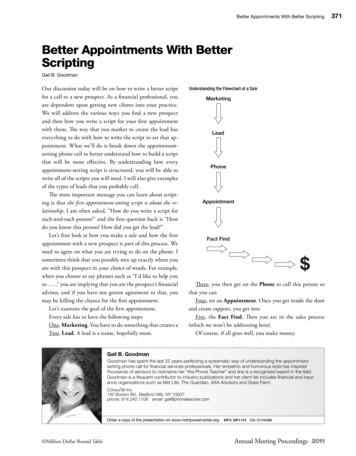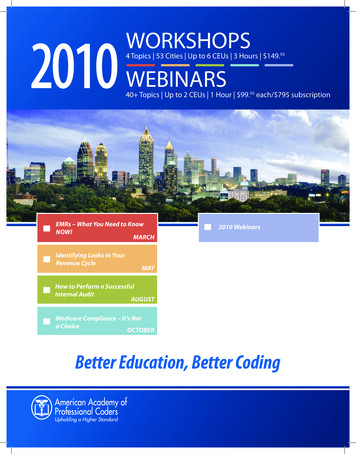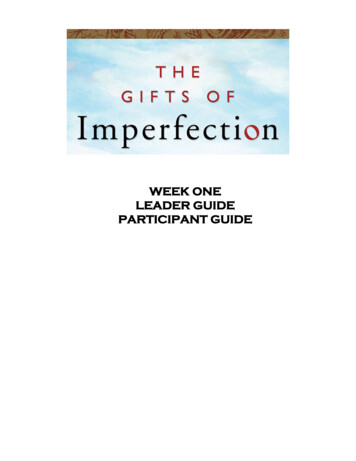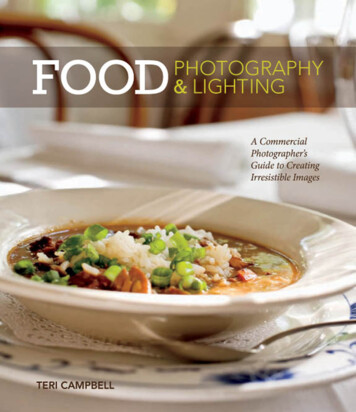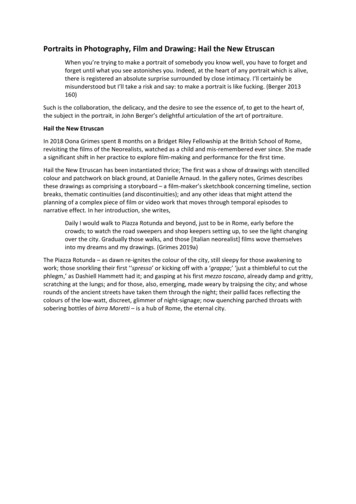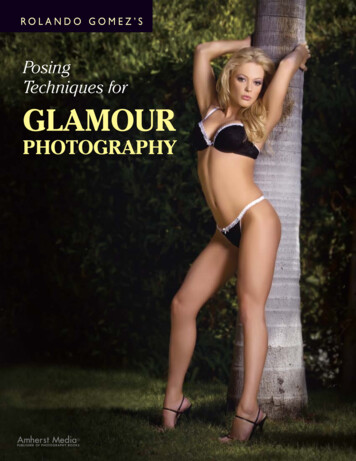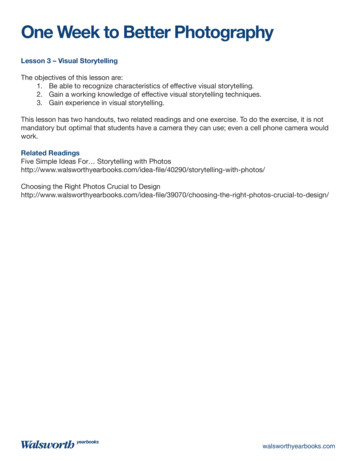
Transcription
One Week to Better PhotographyLesson 3 – Visual StorytellingThe objectives of this lesson are:1. Be able to recognize characteristics of effective visual storytelling.2. Gain a working knowledge of effective visual storytelling techniques.3. Gain experience in visual storytelling.This lesson has two handouts, two related readings and one exercise. To do the exercise, it is notmandatory but optimal that students have a camera they can use; even a cell phone camera wouldwork.Related ReadingsFive Simple Ideas For Storytelling with 40290/storytelling-with-photos/Choosing the Right Photos Crucial to walsworthyearbooks.com
Visual Storytelling Handout – Telling a story with imagesAs a yearbook photographer, you are a journalist with a camera. Good photos, full of interaction,emotion and expressions will make the year come alive to yearbook readers. Great visualstorytellers, like great journalistic writers, rely on the basic strategies of great reporting.1. Know your subject – Do background research before the event. Find out what will betaking place and the significance of individual people and activities. Unless you know thesubject, all of the other reporting techniques are difficult to apply.2. See the image environment – Think format, background, metering and lighting. Pre-thinkmetering and learn to use flash effectively.3. Observe before you start shooting – Watch how the action unfolds and anticipate thebest moments to make photos. Constantly scan the situation for interesting imagepossibilities of the event itself and related activities, for example, a football game and thefans in the stands.4. Look for the lead image – Be alert for the single image that best captures the event’spurpose and mood.walsworthyearbooks.com
5. Break down the story – Just as a writer uses separate paragraphs to tell different parts ofthe story, you need to capture different parts of the story in individual images. Make sureyou leave the assignment with a set of images that tell the complete story.6. Follow through – Great photo moments are often followed by another great moment. Keepshooting and make sure you have plenty of battery power to do it.7. Work for visual variety – Remember, the editors may want to publish more than one imagefrom the event. Visual storytellers need to be alert to opportunities to capture diversecontent using varied formats and a variety of camera angles and positions.8. Capture the continuity – Work to capture the flow of the event from beginning to end. Bealert for cause-and-effect images and images that provide visual context for subjects usingforeground and background information.9. Find the closer – A good reporter follows the story to the end. Visual storytellers need tokeep taking photos even though the main part of the event or action may have ended. Lookfor the images that show subjects in unguarded moments after the event. Answer the “whathappened next” question for the reader. Some of the most interesting images for readersare the ones that capture action and expression that they did not stick around to see.walsworthyearbooks.com
Visual Storytelling Handout – Photo shooting checklistYour newer photographers may need some help once they go on assignment. Here is a checklistthat can be placed in every yearbook camera bag or taped inside every photographer’s notebook,as a reminder for certain tasks. This checklist was created by Jill Chittum, Walsworth yearbook salesrepresentative in Arkansas and Oklahoma, for her publications staffs when she was an adviser atBlue Valley High School in Stilwell, Kan.1. Before you leave the classroom, make sure you have a charged battery and your CF or SDcard. Double-check the camera bag to make sure all equipment is there and working.2. Before you take any photos, erase (format) your CF or SD card using the camera’s menufunctions. This allows you to start with plenty of memory, and may help you avoid deletingimages as your card fills up.3. Before you begin shooting photos at your assignment, assess the lighting situation. Indoor?Outdoor? Fluorescent? Tungsten?4. Set the white balance (WB) so it is appropriate for your situation, using the camera’s menu.5. Set your ISO. Use the following as a guide: Night football: 1600 Volleyball/Basketball/Pep Assemblies (anything in gym): 1600 Most classrooms: 800 Outside/Cloudy or Overcast Day: 400 Outside/Sunny Day: 100 or 2006. Set your camera to manual (M) mode so you can control the shutter speed and aperture.7. Based on lighting conditions, set your shutter speed and aperture so your images will beproperly exposed. USE YOUR LIGHT METER.8. Gather caption information while at the assignment. Get names (spelled correctly), grade/position, and ask a few questions about what they are doing while you are there. It can behelpful to jot notes about clothing and looks so that you match the proper face with nameswhen you are back in the yearbook room.9. Return the camera to the cabinet as soon as possible so it is available for the nextphotographer. Double-check to verify that all equipment you left with is in the bag. If there isa dead battery, put it on the charger, and leave a note with the bag.walsworthyearbooks.com
Visual Storytelling Exercise – Visual journalingTo practice visual storytelling, you need to record observations. Use any one, or combination of, thefollowing recording methods: Film camera or single-use film camera Digital camera Note padA day in the lifeSelect one day in your life to document with images or descriptions of images. Cover the day frombeginning to end in a way that makes for good visual storytelling. Take or describe moments that are significant. Take or describe moments that are visually interesting. Work to get a collection of images or image descriptions that document more than just aseries of events. Make sure your images or descriptions capture the mood of the day. Remember to vary the camera angle and distance from the subject. For each image, provide written captions that include information not obvious from thevisual information.EditingSelect from all of the images or descriptions of images collected during the day. Edit down to a fewimages that best tell the story of that day in your life.SharingYou will be sharing the images or image descriptions with the rest of the class for a class critiquesession. Save your best five to seven images to a jump drive or other means so they can beaccessed in class.walsworthyearbooks.com
Visual Storytelling Handout – Telling a story with images As a yearbook photographer, you are a journalist with a camera. Good photos, full of interaction, emotion and expressions will make the year come alive to yearbook readers. Great visual storytellers, like great journalistic wri
